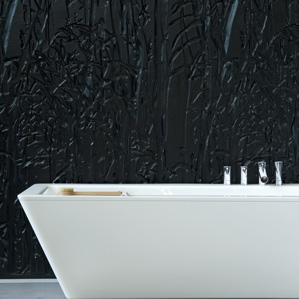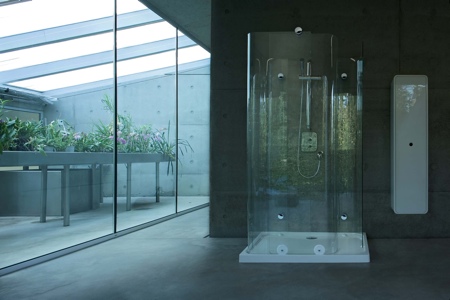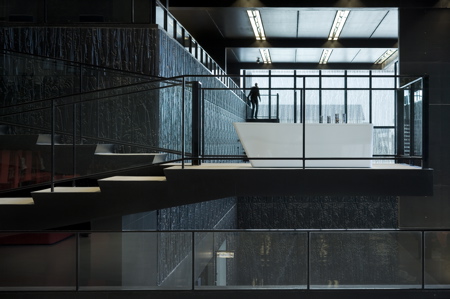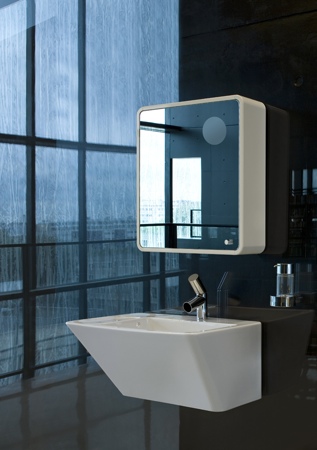
Wiel Arets for Alessi
Milan preview: Dutch architect Wiel Arets has designed a bathroom range for Alessi, which will be launched in Milan next week.

Called Il Bagno Alessi Dot, the range includes bathtubs, shower cabin, sanitary ware, furniture, accessories and faucets.

The range is only the second time Alessi has ventured into bathroom design, following the Il Bagno Alessi One designed in 2002 by Stefano Giovannoni.

Furniture, ceramics and accessories are provided by Laufen and faucets by Oras.

Here are the details of the Milan launch, with statements from Alberto Alessi and Wiel Arets below:

EVENT: IL BAGNO ALESSI Dot
VENUE: Emporio 31 zone, via Tortona 31, Milan
DATE & TIME: Wednesday 18th to Monday 23rd April. Open 10am to 10pm. Friday 20th April, open until midnight for the Zona Tortona “Design Night". Press Preview, Tuesday 17th April (3pm to 7pm).

>> see more of dezeen's exclusive Milan previews here

--
Statement by Alberto Alessi:
"Following the ILBAGNOALESSI One project (2002) designed by Stefano Giovannoni, it was difficult coming up with a new Alessi designer with whom to entrust the next project for the bath area. My decision was to look outside the field of architects specialising in product design and, instead, to work with someone who builds contemporary buildings.
"Alessi’s collaboration with Wiel Arets began in 2000 with an invitation to participate in the 'Tea & Coffee Towers' project. From the instant I received his earliest sketches I began thinking that this peculiar Dutch architect, at once both pragmatic and intensely intellectual, could become one of our ‘design heroes’ of the ‘00s.
"A singular figure, an independent thinker, an integral part of the Dutch architecture scene while remaining at the same time a case apart, Wiel Arets doesn’t follow trends, nor can he be easily classified. A key proponent of the ontological rather than representational approach to architecture (K. Frampton), his work tends towards a regularity of parts, without being minimalist in the reductive sense. It involves a high level of intellectual complexity whilst also being very concrete, and aims at the majority of people with modesty and attention.
"A master of materials both in their crudest and also most surprisingly refined form, unlike many of his colleagues the central premise of his architecture does not reside in the sculptural or iconic elaboration of form, but tends toward a condensation and intensification that creates the special aura of lightness and consistency that characterises his work.
"The ILBAGNOALESSI Dot bath project reflects one of his characteristic compositional strategies: the recourse to unfamiliar juxtapositions, the occasional use of conventional forms alongside unconventional ones. The result, in my view, generates a subtly refined sense of weightlessness that is rather rare in today’s product design. An excellent example, therefore, of how much architecture, magistra omnium artium, can still give to contemporary design.
"P.S. In 2007-2008 we plan to include a number of new concoctions in our catalogues by this designer which have been bubbling on the stove for the past few years.
- Alberto Alessi
--
Statement by Wiel Arets:
"BODY AND WATER. Our relationship with water is more profound than that with any other element on earth. Of course air and light are very important to every living thing, but water has a value that extends beyond the need to ingest it.
"Our bodies consist of 50 to 75% water, depending on our age. By far the greatest part of the earth, as yet the only known place in the universe to contain life, is covered by water in one physical form or another. Water is food for our 70 trillion cells, so that we may function; as ice and snow, it is a substance on which living creatures can propel themselves forward.
"Perhaps the most relaxed relationship we have with water in its liquid form is when we go swimming, or when we wash ourselves with it daily to cleanse our bodies. The gentle surge of the sea may be regarded as one of the most relaxing of sounds, nor do we ever tire of watching running water or gazing at a waterfall.
"There is a centuries-old tradition that shows that we humans have made washing and body cultivation part of our domestic culture. The Egyptians, Greeks and Romans had a variety of purification rituals, of which the best-known is bathing in communal spaces. Bath houses, as we still know them today, were places of cleansing and relaxation, and of dialogue.
"Here, minds were sharpened and contacts made; besides relaxation it was the place where the foundations of cultural development were to be found. Only the exceedingly rich had a place for these activities in their own homes.
"The first toilet, shower and bath, known to us from illustrations, are not that far removed in form from the ones made today. Culture, relaxation, nutrition and hygiene, whatever their relation to water, are arguably the most important reasons why our average lifespan has increased by 30 years during the past two centuries.
ILBAGNOALESSI Dot AS CONCEPT
"If we look at the evolution of artefacts used in bathing culture in the last few thousand years as passed down to us in wall paintings and writings, we see that they are only a means to body care and not an end in themselves. They have always been designed with use in mind and therefore required a physical form that was functional and without aesthetic expression.
"To this day, in Japanese culture showers are taken by sitting on a small wooden stool and emptying water from a wooden bucket over the head and body. This is followed by lathering up with soap, scrub lotion and shampoo. The bather then soaks in a square wooden tub of very hot water, either alone or with others depending on the circumstances, to prepare the mind for whatever lies ahead. The passive seated position is typical of the Japanese approach to purifying mind and body. All attributes are tuned to it, wood being the pre-eminent material for this purpose.
"ILBAGNOALESSI Dot is a collection whose design steps off from the premise that its individual pieces should not distract from the wish to purge the body of impurities. Every component of each item should be in the service of relaxation. Within this frame of reference the circle, though not explicitly present, is the key design determinant for the ceramic items, chrome-plated elements and furniture alike.
"The formal idiom is kept to a minimum and is repeated in all components to emanate first a sense of repose and only then a fitness for purpose that gives cause for comment. Thus the chamfered shape of the ceramic items, together with the circle and the constantly recurring diameters van 48 mm for the taps and 40 mm for the accessories, is intended to reflect an elegance of restraint.
"The bath and the basins have a fully flush upper surface allowing and even encouraging cleaning fluids and other equipment to be placed right next to the water holding recesses, within easy reach. The components from which the taps are assembled share a single diameter so that there is no sense of hierarchy; the same holds for the accessories. The glass of the shower booth relates to the other items and to its surroundings as an autonomous feature unmediated by elements foreign to it.
"It should be clear by now that the combination of all pieces in the collection proceeds from the individual strength of each one, which has its own role to play though without being overbearing.
"The furniture assumes the formal idiom of the sanitary ware, engaging with it in a harmonious relationship. Altogether, and for this reason, it is a well-balanced collection whose aim is to allow its users to enjoy to the full the quintessential element our planet has to offer, namely water.
Wiel Arets